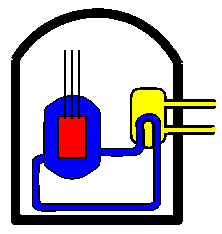
In a Pressurized Water Reactor (PWR), the uranium is located in the core (red). Heat generated from the "burning" of uranium is transferred to circulating water in the primary loop (blue). The primary loop is kept at high pressure, so that even though the water temperature is much greater than 100°C, it does not boil.
The primary loop passes through a steam generator, where it heats the secondary loop (yellow). The secondary loop water changes to steam in the steam generator. The generated steam is then used to turn a turbine, which is connected to a generator. The turning generator produces electricity.
After passing over the turbine, the steam is cooled and condensed by a third loop from a cooling tower or pond and sent back to the steam generator to repeat the cycle.
The "burning" of uranium is an unusual nuclear reaction called fission. The process starts when nucleus of U235 absorbs a neutron. (U235 is much rarer than the normal type of uranium: U238. A nucleus of U235 has 92 protons and 143 neutrons [92+143=235].) For an instant following U235's absorption of a neutron, U236 is formed, but it almost immediately it breaks up into several parts. Most of the neutrons and protons end up in two big pieces (which might be xenon and zirconium, but just about any element might be produced as a fission product) and 2-4 neutrons. The "burning" of uranium is called a chain reaction, because while it takes a single neutron to start the reaction, the reaction produces more neutrons than were used. Thus one fission can produce 3 neutrons; which can produce 3 additional fissions, and 9 neutrons; which can produce 9 additional fissions, and 27 neutrons, etc. The reaction is controlled by changing the fraction of the produced neutrons that end up causing fissions. (For steady power production, one wants about 1/3 of neutrons to be absorbed in U235.) The fraction that end up causing further fissions can be controlled by moving the control rods, which like uranium can absorb neutrons, but unlike uranium do not fission. When the control rods are deep inside the core, the rods rather than uranium absorb most of the neutrons. When the rods are removed, they absorb few neutrons, and more of the neutrons end up causing fissions.